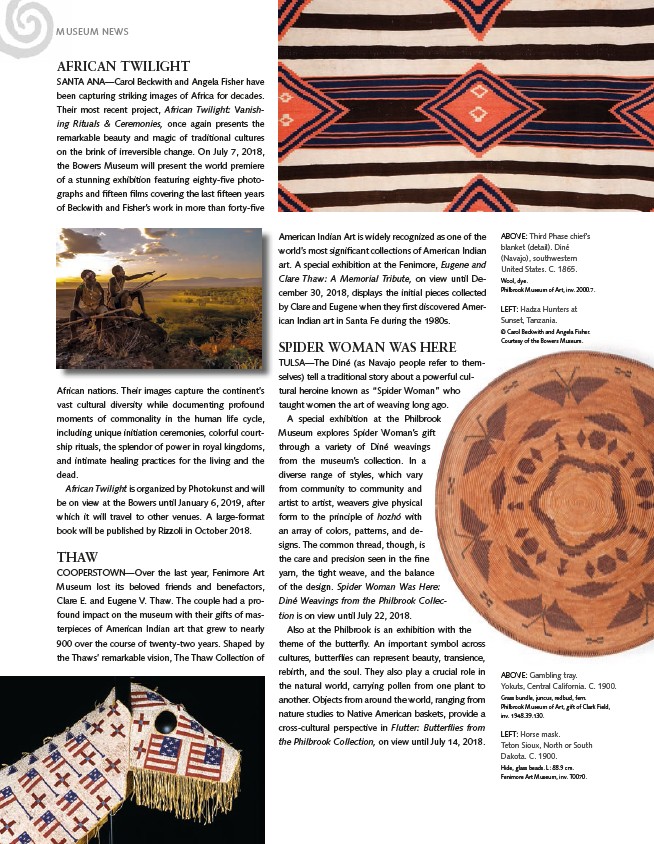
MUSEUM NEWS
AFRICAN TWILIGHT
SANTA ANA—Carol Beckwith and Angela Fisher have
been capturing striking images of Africa for decades.
Their most recent project, African Twilight: Vanishing
34
Rituals & Ceremonies, once again presents the
remarkable beauty and magic of traditional cultures
on the brink of irreversible change. On July 7, 2018,
the Bowers Museum will present the world premiere
of a stunning exhibition featuring eighty-fi ve photographs
and fi fteen fi lms covering the last fi fteen years
of Beckwith and Fisher’s work in more than forty-fi ve
ABOVE: Third Phase chief’s
blanket (detail). Diné
(Navajo), southwestern
United States. C. 1865.
Wool, dye.
Philbrook Museum of Art, inv. 2000.7.
LEFT: Hadza Hunters at
Sunset, Tanzania.
© Carol Beckwith and Angela Fisher.
Courtesy of the Bowers Museum.
ABOVE: Gambling tray.
Yokuts, Central California. C. 1900.
Grass bundle, juncus, redbud, fern.
Philbrook Museum of Art, gift of Clark Field,
inv. 1948.39.130.
LEFT: Horse mask.
Teton Sioux, North or South
Dakota. C. 1900.
Hide, glass beads. L: 88.9 cm.
Fenimore Art Museum, inv. T0070.
African nations. Their images capture the continent’s
vast cultural diversity while documenting profound
moments of commonality in the human life cycle,
including unique initiation ceremonies, colorful courtship
rituals, the splendor of power in royal kingdoms,
and intimate healing practices for the living and the
dead.
African Twilight is organized by Photokunst and will
be on view at the Bowers until January 6, 2019, after
which it will travel to other venues. A large-format
book will be published by Rizzoli in October 2018.
THAW
COOPERSTOWN—Over the last year, Fenimore Art
Museum lost its beloved friends and benefactors,
Clare E. and Eugene V. Thaw. The couple had a profound
impact on the museum with their gifts of masterpieces
of American Indian art that grew to nearly
900 over the course of twenty-two years. Shaped by
the Thaws’ remarkable vision, The Thaw Collection of
American Indian Art is widely recognized as one of the
world’s most signifi cant collections of American Indian
art. A special exhibition at the Fenimore, Eugene and
Clare Thaw: A Memorial Tribute, on view until December
30, 2018, displays the initial pieces collected
by Clare and Eugene when they fi rst discovered American
Indian art in Santa Fe during the 1980s.
SPIDER WOMAN WAS HERE
TULSA—The Diné (as Navajo people refer to themselves)
tell a traditional story about a powerful cultural
heroine known as “Spider Woman” who
taught women the art of weaving long ago.
A special exhibition at the Philbrook
Museum explores Spider Woman’s gift
through a variety of Diné weavings
from the museum’s collection. In a
diverse range of styles, which vary
from community to community and
artist to artist, weavers give physical
form to the principle of hozhó with
an array of colors, patterns, and designs.
The common thread, though, is
the care and precision seen in the fi ne
yarn, the tight weave, and the balance
of the design. Spider Woman Was Here:
Diné Weavings from the Philbrook Collection
is on view until July 22, 2018.
Also at the Philbrook is an exhibition with the
theme of the butterfl y. An important symbol across
cultures, butterfl ies can represent beauty, transience,
rebirth, and the soul. They also play a crucial role in
the natural world, carrying pollen from one plant to
another. Objects from around the world, ranging from
nature studies to Native American baskets, provide a
cross-cultural perspective in Flutter: Butterfl ies from
the Philbrook Collection, on view until July 14, 2018.